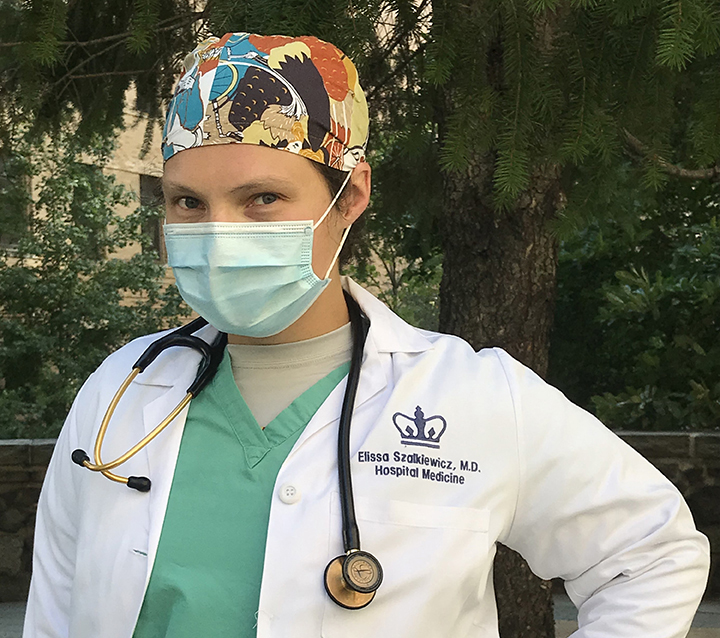On the frontline with Lissy Szalkiewicz
For two months, Manhattan doctor cared only for coronavirus patients

After a nearly two-month span in which physician Elissa “Lissy” Szalkiewicz ’08 saw hundreds of patients, her mind can easily flash back to outcomes on both ends of the spectrum. There were patients who FaceTimed with relatives just before dying and there were patients who went home after a short hospital stay. During the peak of the coronavirus in New York City, Szalkiewicz saw a bit of everything.
Szalkiewicz works at Columbia University Medical Center in Manhattan, taking care of patients admitted from the emergency room. Normally, she sees patients with a variety of conditions. In March and April, however, it was nothing but coronavirus cases.
“This was very difficult for providers, patients and families because we had to deal with something we had never seen before,” Szalkiewicz says. “Initially we weren’t sure if the patients were going to get better or worse. It’s never a good feeling when you go in to see a patient, and they’re looking good, but you’re not sure what will happen over the next few hours.
“If we were able to send them home, we didn’t know if they would need to come back or would pass away in their homes. There were times when I felt helpless.”
Szalkiewicz leaned on her medical school training and residency experience, which required her to work long hours and handle a large patient load. She also said her Binghamton University experience — she was a math major and avid co-rec player — helped her think through situations logically, anticipating what would come next and working as part of a team.
The Columbia staff was very nimble, she says, increasing the number of floors taking only coronavirus patients, expanding intensive care units (ICU) and making use of all available space.
“By coming up with unique and ingenious ideas, we were able to properly care for our patients,” Szalkiewicz says. “We had a tent outside the Emergency Department capturing patients on their way to the department. We’d see if they had coronavirus symptoms, check their vital signs and determine if they had to be admitted or if they were stable enough to return home with virtual follow up. We rapidly recognized patterns concerning the disease presentation and course, and frequently adapted our treatments based on the newest information. We spent many hours supporting our patients and connecting them virtually with their family members who were stranded at home.”
By May, there were fewer admissions to Columbia’s hospital, more patients were being discharged and some of the recently added ICUs closed. The darkest time had passed.
“It was definitely a scary, unfathomable time for everyone, but we saw the best of people,” Szalkiewicz says. “Every night at 7, people would clap for us. The hospital got a lot of food and supply donations. When we were scared that we’d run out of PPE, companies quickly donated PPE. New Yorkers did their part in helping to stop the spread and stayed home, social distanced and wore masks. We, as healthcare professionals, really appreciate all the support.”

